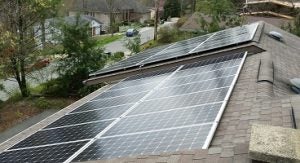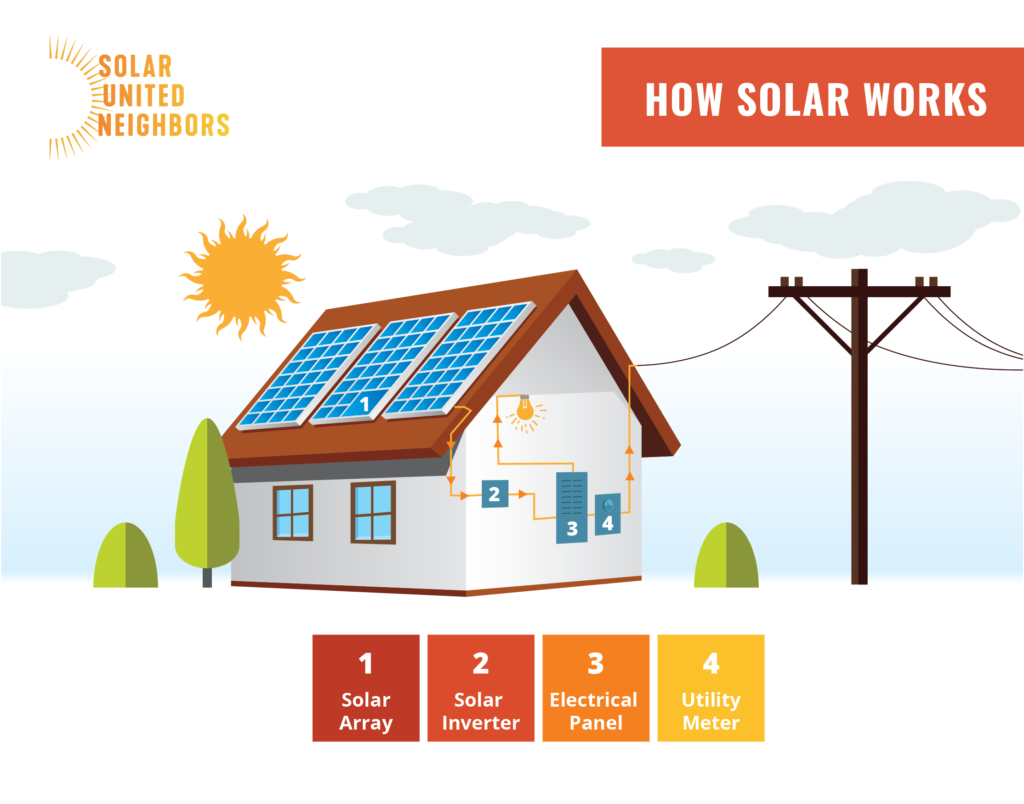How do solar systems work?
How do solar systems work?
Solar panels are made up of photovoltaic (PV) cells made of silicon. When the sun’s rays hit them, these cells convert sunlight to electricity. Individual cells are wired together to form a solar panel. Panels are typically three feet by five feet. They are coated in tempered glass, which allows them to withstand harsh weather.
 The electricity produced by a single solar panel is not enough to power a home or business, so multiple solar panels are needed. The number of panels varies by installation, but every solar system (also called an “array”) will include a series of panels mounted and wired together. This array may be installed on a roof (“rooftop solar”) or on the ground-level (“ground-mounted solar”).
The electricity produced by a single solar panel is not enough to power a home or business, so multiple solar panels are needed. The number of panels varies by installation, but every solar system (also called an “array”) will include a series of panels mounted and wired together. This array may be installed on a roof (“rooftop solar”) or on the ground-level (“ground-mounted solar”).
The electricity generated by solar panels takes the form of direct current (DC). However, most appliances and electricity-consuming objects (called “electric load”) require alternating current (AC). To convert the solar electricity from DC to AC, an inverter is needed. You will need to choose between two types of inverters: a central inverter and microinverters. While both perform the task of converting electricity from DC to AC, they differ in critical ways.

A central inverter receives all of the electrical output of your entire solar system and converts it from DC to AC at a single, central location. A single central inverter is required for a solar system. It is often mounted on the side of your home or building next to your electric meter. Central inverters are steadfast and affordable, but they are susceptible to variations in panel performance. If one panel is shaded and produces less electricity than the others, the total electrical output will drop.
If shading is of concern, microinverters or DC optimizers can help maximize production. Unlike central inverters, microinverters and DC optimizers individually mount to the backside of each individual solar panel. They capture the electricity that flows off of each panel. DC optimizers work with a central inverter that converts DC to AC. Microinverters convert DC immediately to AC right under the panel. With either DC optimizers or microinverters, if one panel is shaded, it will not affect the output of the whole array. By design, both DC optimizers and microinverters help maximize the conversion of electricity and are useful in situations with variable shading. What’s more, because they allow each panel to operate independently of one another, both make it easy to add more panels to a solar array in the future.
Once electricity is produced by the solar panels and converted from DC to AC by the inverter(s), it will flow through your electric meter and into your home or building. It will be used on site the moment it is created. Any excess will flow back out through your electric meter and onto the local grid.

